What if the public’s fears about common exposures to radiation were not only baseless, but the product of epic science fraud? And what if the people we have trusted with setting radiation safety standards have knowingly suppressed that reality for decades, including up to the present day?
JunkScience.com is presenting for the first time emails uncovered via the Freedom of Information Act that expose the inner workings of a little-known bureaucracy dedicated to keeping in place the so-called “linear non-threshold model” (LNT). The LNT is used by regulatory agencies to set permitted exposure standards for radiation.
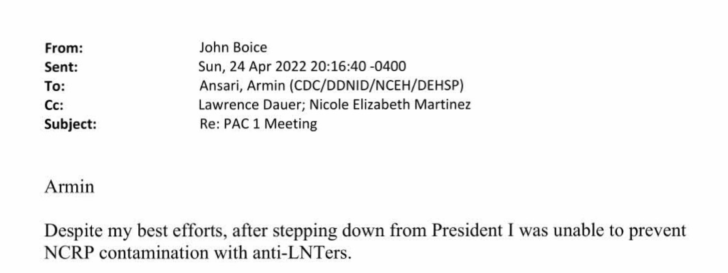
So if you have been concerned or scared of anything associated with radiation — from medical diagnostics to TSA screening to radon in your basement to nuclear power plants — you have been an unwitting victim of the LNT. As explained in this recent article, the LNT has been responsible for producing crippling fear of low-level radiation exposures.
These emails are to and from a veritable Who’s Who of the current radiation safety establishment, including employees and affiliates of the US Environmental Protection Agency (EPA), National Council on Radiation Protection and Measurements (NCRP), the National Academy of Sciences (NAS) and the Health Physics Society (HPS).

Depending on the reader’s familiarity with the LNT and the recent exposure of it as science fraud by Ed Calabrese of UMass Amherst, it is recommended that readers first watch and have their minds blown by the amazing 22-part Health Physics Society (HPS) video series featuring the incomparable Calabrese’s unparalleled research on the origins and development of the LNT: HPS.org | YouTube.com. It is 10 hours of truly incredible content. No exaggeration. A written summary of the video series is here (Web | PDF). A two minute-long teaser clip is below.
Top off your shock and amazement by reading what the FOIA-ed emails show is occurring now. You will no longer wonder why the LNT remains in use despite lacking any sort of scientific underpinning. But you will perhaps start to wonder why anyone believes any sort of government-related science at all.
Why you should care about this:
- Radiation safety standards. Virtually all radiation safety standards — e.g, medical and dental treatment, occupational exposure standards, nuclear plant safety, radon in the home — are all based on the LNT. The International Commission on Radiological Protection (ICRP), an independent non-government organization, is currently undertaking a review of its recommendations for radiation safety. The HPS video series was produced with an eye toward informing it on the actual history of the LNT.
- Chemical safety standards. All chemical safety standards addressing cancer risk — e.g,. EPA drinking water, air emission and hazardous waste clean-up standards — are based on the LNT. The LNT gives regulatory agencies like EPA maximum arbitrary power over the regulated community and the public mind.
- Medical imaging. Many members of the public refuse diagnostic x-rays, fearing a risk of cancer predicted by the LNT.
- Nuclear power. Excessive fears of nuclear power and nuclear accidents come from use of the LNT. These fears can themselves be deadly. No one was directly killed by radiation from the 2011 nuclear accident at Fukushima, but more than 1,600 people died in the ensuing panicky evacuation.
- Nuclear war. The possibility of nuclear war and or a dirty bomb detonated in an urban area or off the coast of, say, California — think Ukraine war, the Iran and North Korea nuclear programs, and China’s aggression toward Taiwan — all raise the the possibility that Americans and others may have to deal with radiation risks and potential evacuations. Strict application of the LNT guarantees these will be hysterical and disastrous.
- Reliability of government and institutional science. For many, there is little more authoritative than media reports with phrases like “Scientists say…” or “Government scientists say…” or “Nobel prize winner says…” But Calabrese’s work shows how terribly wrong it is to treat scientists, especially government and institutional ones, as if they exist on some higher moral and intellectual plane than the rest of us. They don’t.
- Other social and economic impacts. The LNT foments fear, which causes poor decision-making during times of crisis. The model implies there’s no safe exposures to radiation resulting in enormous costs to building nuclear plants or cleaning up contaminated environments to prevent low level exposures that pose no threat. Thus, applying the LNT wastes resources via an unjustified fear that ultimately harms public health.
1. Introduction
The linear no-threshold model (LNT) for cancer risk assessment is the foundation for a vast amount of radiation and chemical regulation in the US. First adopted by the radiation safety community in the 1950s, the US Environmental Protection Agency (EPA) has been its main sponsor and enforcer since the 1970s. Nonetheless, over the decades, many scientists and radiation safety experts have questioned the scientific validity of the LNT in the low dose/exposure range, and the EPA’s strict and unyielding application of it for those low doses/exposures, which happen to represent the vast majority of regulated exposures.
Over the past several decades, University of Massachusetts professor Ed Calabrese has conducted truly amazing historical research about the LNT’s origin and history. Calabrese’s work revealed the true and sordid history of the LNT’s development. He has demonstrated beyond reasonable doubt that the LNT was adopted for low doses/exposures despite it not having any supporting scientific data. To apply the LNT to low dose/exposure situations and call it “science” can now be shown to be an utter fraud. Words fail to do justice to the stark nature and significance of Calabrese’s revelations.
Until recently, Calabrese has been content to publish his findings in peer-reviewed academic journals. JunkScience.com has spotlighted many of them over the years. But in 2021, the Health Physics Society (HPS), a prestigious society of radiation safety experts and professionals, approached Calabrese to report his findings to the wider public. The result is a compelling 22-part, 10 hour-long video series which can viewed at HPS.org, YouTube.com or at JunkScience.com.
Shortly after the HPS video series was released in April 2022, an activist conducting research on a separate topic shared responses from a Freedom of Information Act request with Calabrese as his work with HPS had been mentioned. Intrigued and not one to leave any stone unturned, Calabrese sent Freedom of Information Act requests to federal agencies that use/rely on the LNT. Much to his surprise and chagrin, the emails revealed a covert campaign to:
- Discredit Calabrese and his video series and to
- Overthrow the current leadership of the HPS because it is viewed as being anti-LNT.
The emails and covert campaign are revealed here for the first time publicly. While Calabrese’s research and video series expose the dishonest way the LNT was developed and cemented into regulatory risk assessment, these emails expose the dishonesty, scheming and unscientific behavior of those trying to keep the LNT cemented in place.
2. Brief Description of the LNT
The linear no-threshold model (LNT) has been relied on by regulatory agencies for radiation and chemical risk assessment since the mid-1950s. The LNT is just a model, that is, an assumption vs. a scientifically validated fact. And it is a crude one at that. It is used to determine permitted levels of exposure to radiation or chemicals when there is no scientific data showing harm at low dose/exposure levels.
In an illustration from the HPS video series (below), the solid blue line shows a range of exposure for which there is real-life or laboratory data showing increasing risk of harm of health with increasing dose of radiation. The dashed blue line shows the exposure range for which there are no data. By use of the LNT, that low dose/exposure risk level is presumed to be linear with increasing dose with no safe level of exposure. [Note: In this illustration the line doesn’t go through the graph’s origin because, in the case of radiation, there is naturally occurring radiation (from the Earth itself and space) that we are all unavoidably exposed to every day (called background radiation). The health risk from this background level is presumed to present zero risk.] But through use of the LNT, all additional radiation risk is presumed to increased the risk of harm in linear (or proportional) fashion.
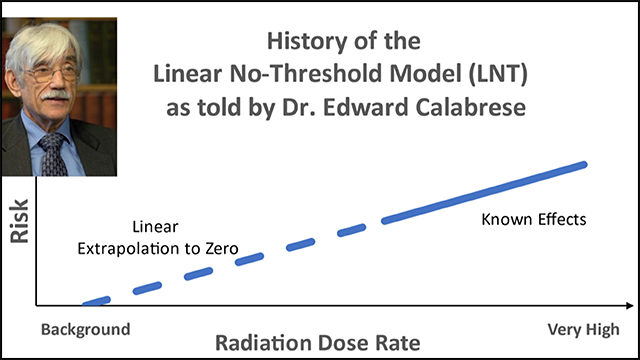
Because the LNT is not based on real-life observations or laboratory data, it is not the product of science, but rather something called “science policy” — i.e., an arbitrary political assumption made to fill a gap in knowledge or uncertainty in the science used in regulatory risk assessment. Science-policy decisions are said to be “conservative” in nature. This is not meant in a political context but in the context of “better safe than sorry.” Science policy decisions are an early form of the so-called “precautionary principle.” There are many types of science policy decisions made in regulatory risk assessment. But the LNT is perhaps the most prominent.
Although the LNT is often used for regulatory risk assessments for exposure to chemicals, the focus, here, will be radiation risk assessment. The gap in knowledge with risk assessment for radiation exposures is the absence of data showing harm from low dose/exposure to radiation. We know from the Japanese atomic bomb survivor data, for example, that cancer risk increases with with proximity to ground zero for the Hiroshima and Nagasaki atomic bombings. The survivors have been extensively studied for decades and the dose-response curve (i.e., analogous to solid blue line in the graph above) is generally accepted to be linear and increasing with proximity to the explosions (i.e., higher exposures).
But what, if any, is the risk from lower and less intense exposures to radiation? The actual shape and nature of dose-response curve in that exposure region is controversial to say the least. To set regulatory standards in that region, where the vast majority of human exposures to radiation occur, the LNT is assumed and used. Although it is often cloaked, presented and discussed as science, the LNT and its application is, in fact, pure guesswork. It is not the product of science, but rather its absence.
The director of the Health and Safety branch of the UK Atomic Energy Authority Dr. Andrew Mclean described the LNT as far back as 1963 as follows:
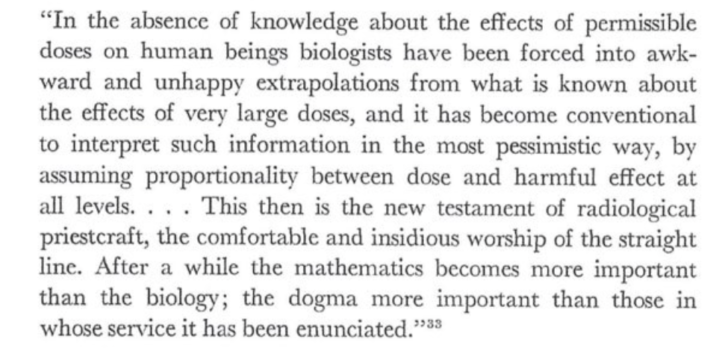
And the practitioners of the “radiological priestcraft” are politically powerful, watchful over their domain and are aggressive in defending it.
Why does the LNT still hold such tremendous sway over regulatory risk assessment and standard setting? A better question to start with might be, how did the LNT come to be used in the first place? Enter, Ed Calabrese.
There is a standard history of the LNT, portraying it as the outcome of Nobel prize-winning science, followed by the adoption of this science by learned committees of the National Academy of Sciences. Then there is the actual history of the LNT as revealed by Calabrese and the Health Physics Society. And that history, without even knowing what it is until Calabrese’s work, is what the LNT priesthood is trying to prevent the world from knowing.
The emails unearthed by Calabrese reveal senior levels of the radiation protection community, prominent individuals and key institutions, scheming not only to undermine Calabrese but also conspiring to seize control of the HPS and to cleanse it of anyone in a leadership role who questions the validity of the LNT.
3. The Calabrese Videos and the Emails
To provide the public and radiation protection community with the benefit of Calabrese’s discoveries, the Health Physics Society (HPS) released in April 2022 a series of videos (HPS.org | YouTube | JunkScience.com) documenting and exposing the historic science fraud behind the LNT that Calabrese single-handedly uncovered.
In July 2022, Theodora Scarato of the environmental activist group Environmental Health Trust (EHT) notified Calabrese of the results of a Freedom of Information Act that EHT had submitted to the US Centers for Disease Control and Prevention (CDC).
Scarato sent Calabrese 1,200 pages of the FOIA results, including email to and from Armin Ansari, a past president of the HPS (2012-2013) and current president-elect of the American Academy of Health Physicists (AAHP). Unexpectedly, these emails contained communications by and between HPS board members and others in the radiation protection establishment critical of Calabrese, HPS leadership and the video series.
After reviewing the emails and wanting to better understand expressed displeasures with HPS video series, Calabrese submitted his own FOIA request to CDC. This action is entirely consistent with Calabreses’s meticulous and thorough research methods. In Episode 4 of the video series, for example, Calabrese revealed how he purchased personal letters between key members of the 1956 National Academy of Sciences’ Biological Effects of Atomic Radiation (BEAR) Committee in order to better understand the motives and relationships that led to their recommendation of the LNT Model for use in risk assessment.
After receiving FOIA-ed material from CDC, Calabrese shared the results with HPS leadership.
The FOIA-ed information reveals a coordinated and covert campaign by John Boice, the past president (2012-2018) and current director of science of the National Council on Radiation Protection and Measurements (NCRP), and some HPS members to “save the Society.”
The cabal intended to accomplish this by covertly recruiting, nominating and electing HPS members to HPS leadership who had views consistent with their own, i.e., ignorant of the LNT’s history yet supportive of it. The emails revealed that many prominent figures in the field of radiation safety are acting to protect the continued reliance on the LNT model by suppressing relevant scientific information and silencing critics like Calabrese.
Only HPS members in leadership positions working at government or public institutions were the subject of Calabrese’s FOIA requests, some of which are still in progress. What follows is a presentation of noteworthy emails. It reveals how leaders in the field of radiation safety who hold influential or prominent positions on national and international committees, academic programs and government agencies nefariously control the exchange of scientific information to the detriment of the rest of us.
This is rank politics and political activism, not science.
4. The ‘Move the Needle’ Plot
Emails show that just days after John Cardarelli was elected president of the Health Physics Society in January 2020, Boice communicated with CDC’s Ansari about the election:
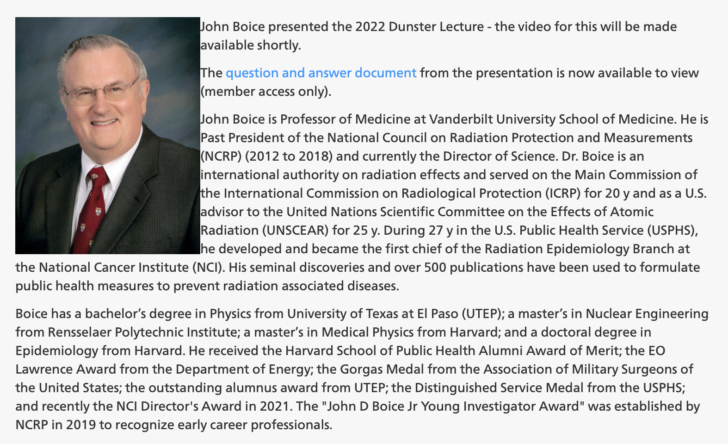
Boice and others held a meeting to discuss HPS during which they expressed concern about its “downward spiral.”
Ansari, Boice and Memorial Sloan Kettering Cancer Center’s Larry Dauer initiated a campaign, including a logo, that Boice referred to as “moving the needle” and defined as “incremental steps for a healthy Health Physics Society and [to] renew the past excellence.”

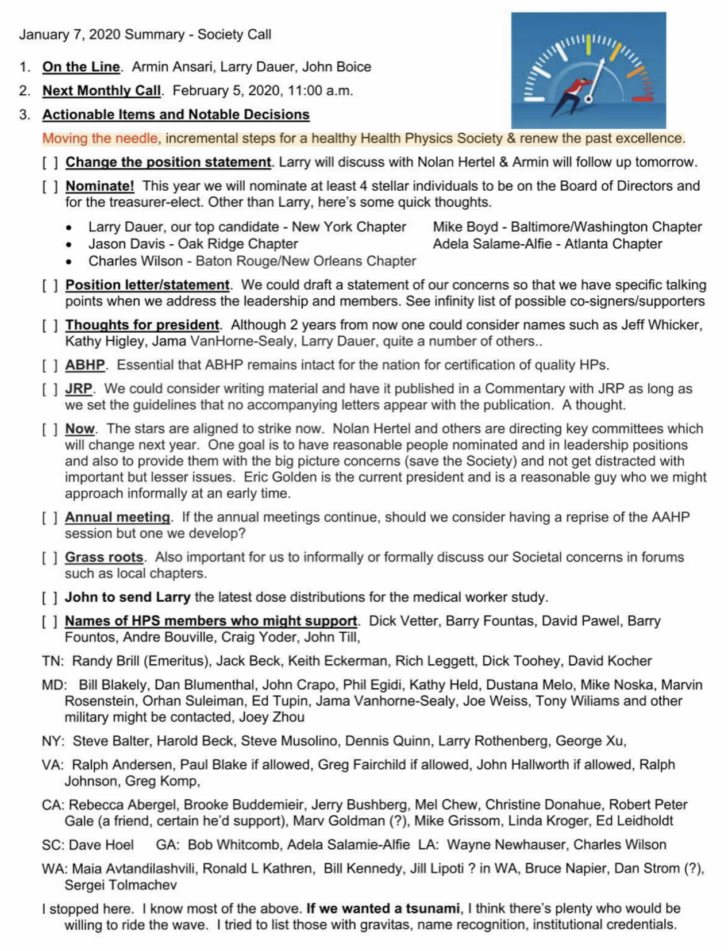
At a meeting to advance the “moving the needle” campaign, several NCRP and HPS members discussed:
- HPS position statements (specifically the HPS document, “Radiation Risk in Perspective“);
- Potential future nominees to run for HPS president and/or board of director positions;
- Concerns on how to “save the Society”; and
- Names of HPS members with gravitas, name recognition and institutional credentials who might support NCRP efforts to “move the needle.”
The email below shows Boice complementing Ansari (“I thing [sic] you moved the needle at least three clicks!”) in response to Ansari beginning to recruit nominees to run for HPS leadership. Dauer is concerned about a conflict of interest in being on the HPS nominating committee while trying to get nominated as a candidate for HPS leadership.
Five months later, Dauer shared his joy at successfully getting the “move the needle” cabal’s candidates nominated at HPS:
Dauer’s efforts resulted in two “move the needle” HPS members (Mike Boyd and Adela Salame-Alfie, both of the NCRP) being elected to the HPS board of directors later that year.

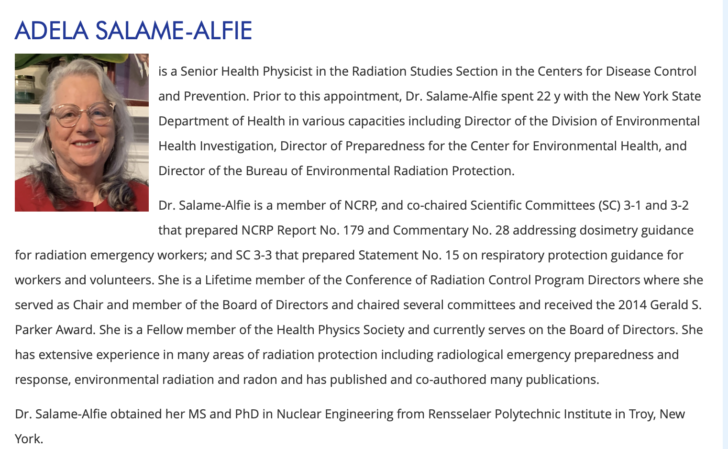
Despite the election of the “move the needle” nominees, it should be noted that:
- Less than 25% of HPS members typically vote in board elections. So such a low turn-out tends to benefit a motivated minority.
- Boyd was a long-term employee of the EPA, which always uses the LNT Model in its radiation and chemical cancer risk assessments. [Note: Boyd retired from EPA and was replaced by Ansari. Boyd now works for Ansari as contractor]
- Salame-Alfie is a CDC employee who worked in the same office as Ansari, who left the CDC and now works at EPA.
- While there is no express rule preventing Dauer from sharing the HPS ballot while serving on the HPS nominating committee, there certainly is an expectation of confidentiality with respect to internal HPS deliberations. Instead Dauer opted to act as a source for Boice and other NCRP members who held multiple meetings on the HPS nominations and elections throughout 2021.
5. HPS releases LNT video series triggering a flurry of NCRP actions
Just ahead of the release of the HPS video series, HPS corporate secretary Nicole Martinez emails John Boice about her effort to talk Cardarelli out of releasing the video series:
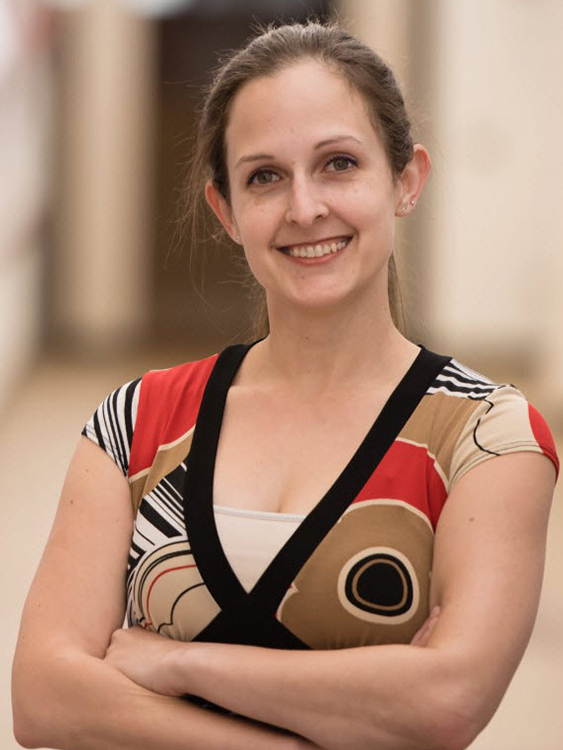
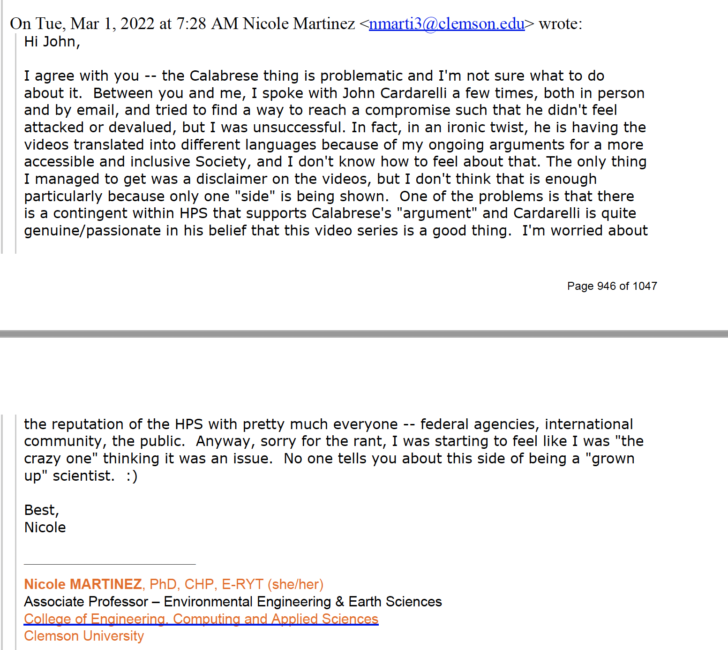
Without having seen the HPS video series, Boice responds with:
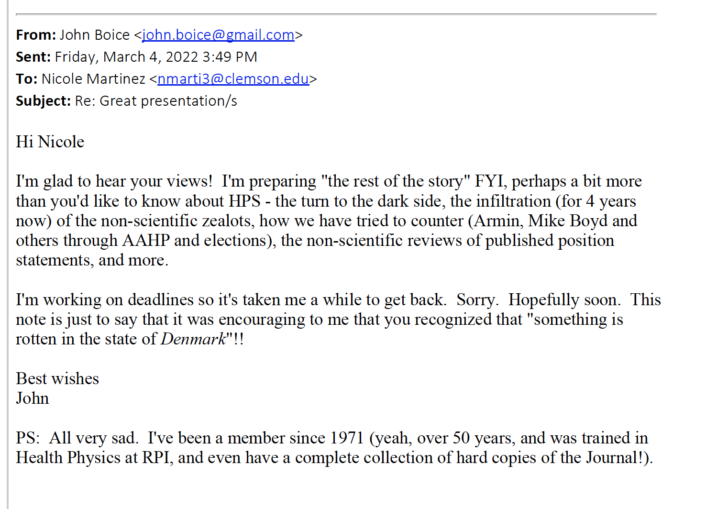
“The rest of story”, per Boice, is revealed in this attachment to an email sent to Martinez on March 10, 2022:
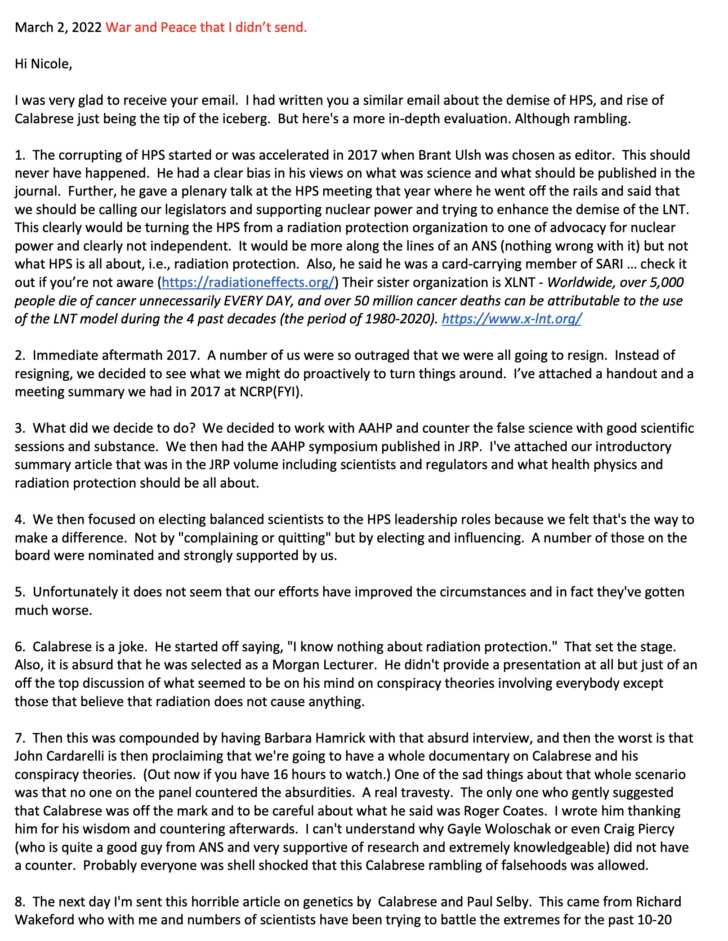

Keep in mind that Boice was President of NCRP for seven years (2012-2018) and is now its director of science. Boice is also a leader on the Million-Person study, proposed research of radiation workers intended to understand the effects of low-dose radiation. Is Boice’s intolerant attitude what he brought every day to his leadership position in what is supposed to be a science-based organization? Is that what can be expected in his leadership of the Million-Person study?
On April 14, 2022, the HPS published the 22-part video series on the history of the LNT model (HPS.org, YouTube.com or at JunkScience.com.) The series has been viewed by more than 16,000 unique IP addresses, in more than 700 cities and more than 70 countries world-wide. It has been widely acclaimed. Calabrese tells quite an amazing story based on original documents, many of which have never before seen the light of day.
Around the time the documentary was released, a flurry of activities occurred within the NCRP leadership. The NCRP’s Boice emailed Ansari:
Despite my best efforts, after stepping down from President, I was unable to prevent NCRP contamination with anti-LNTers.
This statement conveys clear animus on the part of Boice towards those holding a different view of the LNT from himself. It raises questions, including:
- Did Boice’s long-term leadership create a culture at NCRP in which only pro-LNT views were welcomed?
- How many nominees were excluded from NCRP membership over the past 10 years because of his bias or influence?
- With his seemingly profound pro-LNT bias, should Boice be leading a study to understand the effects of low-dose radiation exposure?
- Will anyone ever find out?
Keep in mind the video series does not explicitly address the suitability (or not) of the LNT model for use in radiation protection. It merely reveals how the U.S. came to adopt the LNT model for risk assessment. This is not a direct anti-LNT message.
What Calabrese exposed is the sordid and non-scientific past of the LNT. That does not necessarily mean that it should not or cannot be used in risk assessment. What it means is that the LNT has no actual basis in science. As discussed before, it is “science policy.” So the problem with the LNT is not so much that it is blindly used. But when it is used, it is portrayed as being scientific in nature when it is clearly not.
If regulators nonetheless choose to use the LNT despite the absence of scientific support — a state that continues to exist almost 70 years after it was adopted — they should describe to the public their ongoing reliance on the LNT as a political or policy choice, not a choice dictated by the extant scientific knowledge. Otherwise, they are lying to the public if not to themselves as well.
But lying to themselves is precisely what they continue to choose to do.
Northwestern University radiation oncology professor and HPS member Gayle Woloschak disparaged Calabrese as a “cultic character.”
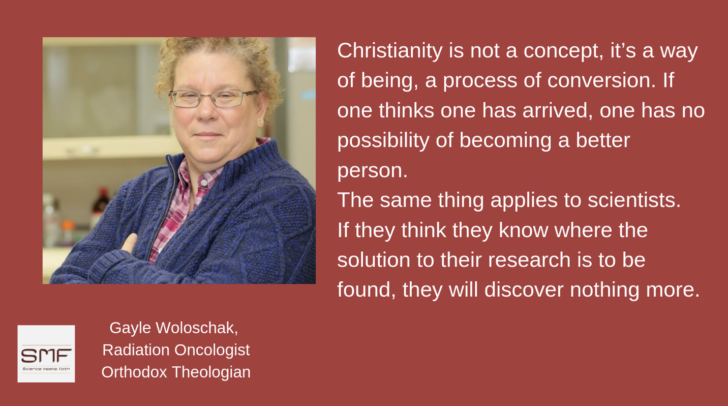
EPA health physicist Philip Egidi called university professor Calbrese “a known corporate hack.”
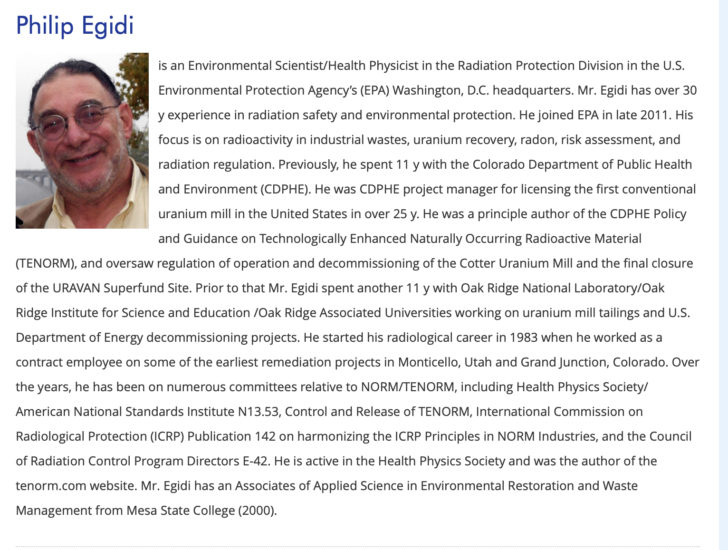
About the video series, newly elected HPS board member and NCRP member Derek Jokisch said he, “couldn’t make it through a single [episode] in their entirety” and labeled them as “low quality junk.”
Martinez, the HPS Secretary and a newly-elected NCRP member stated, “I can’t even make myself sit through a video.”
Juvenile name-calling aside, their much more nefarious action was to ignore Calabrese’s discoveries. None of them are specifically addressed. They just engage in ad hominem attack.
While the cabal doesn’t like Calabrese, it does meet to talk about him and his work.
In the email below, Woloschak (via her secretary Laura Atwell) sets up a meeting of the NCRP’s “PAC 1: Basic Criteria, Epidemiology, Radiobiology, and Risk” committee specifically to discuss Calabrese and the HPS video series.
Amid the uproar about the videos series, Boice told Martinez that his concerns about HPS dated back to 2017 when LNT-critic Brant Ulsh was selected as editor-in-chief of the Health Physics Journal.
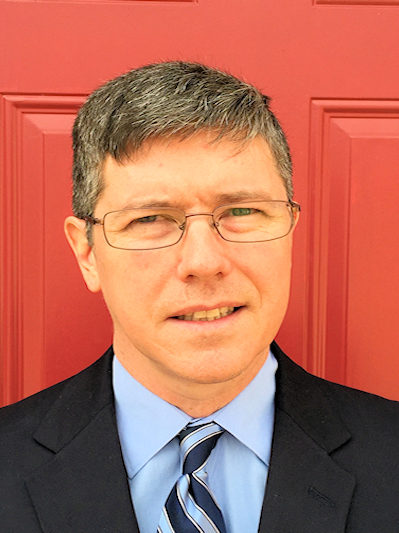
Following a 2017 presentation at an HPS meeting by Ulsh on the LNT, Boice expressed outrage and considered resigning from the Society. Instead, he stayed and organized an effort to “turn things around” by working with the American Academy of Health Physics (AAHP) to counter alleged “false science with good scientific sessions.” During the 2018 HPS annual meeting in Cleveland, Boice participated in an AAHP special session in which Calabrese had been initially invited to be a speaker and then was disinvited by the AAHP president, Kyle Kleinhans.
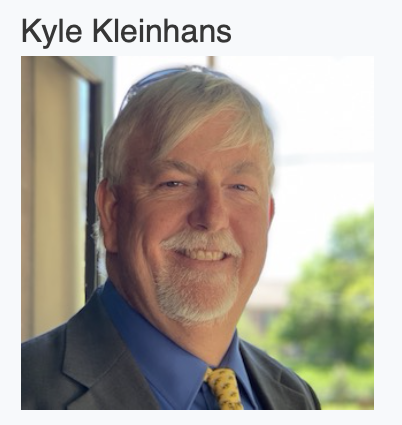
Kleinhans reassured Calabrese that the disinvitation was neither personal nor political, and stated to another AAHP member who questioned the decision that he decided to change the focus of his special session and Calabrese didn’t fit with the new focus.
Later, Kleinhans co-authored a publication summarizing the session stating that it, “was structured to describe the current state of science, from molecular biology to human epidemiology, as well as to explain how that science is translated to radiation protection policy and regulations for low levels of radiation” (Ansari, Kleinhans, & Boice, 2019). This focus is very consistent with Calabrese’s publications.
That session was led by the Ansari and Kleinhans with Boice filling the Calabrese speaker slot. As recounted by Calabrese during a 2022 lecture, the actions of the AAHP leadership were unprofessional, disrespectful, self-serving and deceitful.
Kleinhans later shared his impression of Calabrese’s video series with HPS president Cardarelli by stating:
I’m a bit embarrassed at my naivete expecting scientists to do the right thing and report all of the relevant data. I wasn’t aware of the bad science and cherry-picking of data done by some of the scientist [sic] to point to their predisposed outcome. I guess I shouldn’t have been too surprised to see a number of the scientist [sic]‘following the money’.
More of that type of exchange is needed.
6. Suppressed opposition to the LNT emerges
Other FOIA-ed emails shows a more balanced view of the LNT, as expressed by radiation safety consultant Graham Smith:
If you take a holistic view of the issues affecting, say, management of radioactively contaminated land, waste disposal, but also use of ionising radiation in medicine, then below about 5 mSv/y you are wasting your time looking at small risks when there are clear bigger risks to be concerned about that deserve anyone’s attention first. And this is true whether you agree with applying LNT, or disagree.
EPA health physicist Mike Boyd also seems on board with moving past the LNT, agreeing with Australian low dose radiation researcher Pamela Sykes’ conclusion:
In the short term, if LNT is left out of the argument, and replaced with suggestions for sensible approaches to improve the ways to reduce financial and administrative burden based on acceptable risk using a graded approach within the current regulatory system, then there will be a clearer path forward toward more sensible regulation of ionizing radiation (Sykes, 2020).
But moving past the LNT doesn’t appear to be on EPA’s agenda as seen in exchanges between then-EPA radiation chief and now director of EPA’s Office of Indoor Air and Radiation, Jonathan Edwards, and then-EPA Office of Emergency Management deputy office director and now-US Coast Guard emergency management director, Dana Tulis. She seeks an open-minded discussion to ensure EPA uses the latest science in its radiation policies. Edwards states his office would never subscribe to opening up the LNT policy for review and that it is “set in stone” EPA policy.
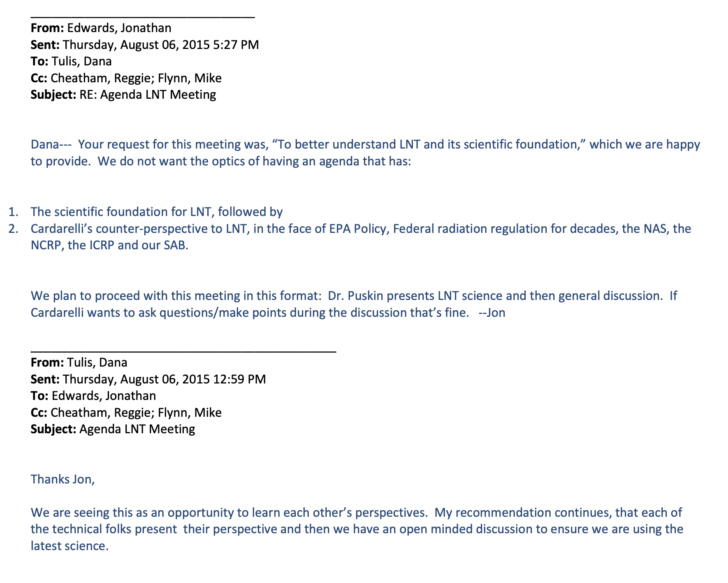

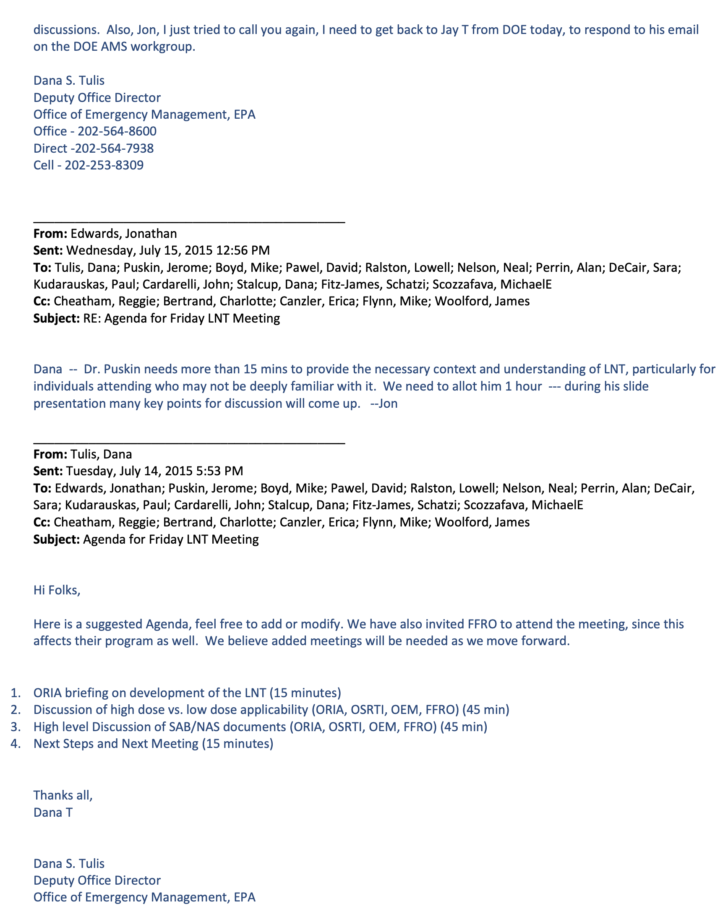
7. National Academy of Sciences Committee view of Calabrese and the HPS documentary
Before the video series controversy, the National Academy of Sciences had established its Committee on Developing a Long-Term Strategy for Low-Dose Radiation Research in the United States.
The Committee was chaired by Joe Gray and included two HPS members, Woloschak and Shaheen Dewji. Email FOIA-ed by Calabrese revealed the concern of the Committee in how to address the video series.
Here Woloschak apprises NAS staff officer Ourania Kosti, chairman Gray, and NAS committee member, current HPS board member and Georgia Institute of Technology assistant professor Shaeen Dewji of the NCRP meeting on the video series and whether the NCRP would respond.
Although no official NCRP response has been delivered to date, during these exchanges, Gray floated the idea of trying to disparage Calabrese as being funded by the U.S. Department of Energy because of the Department’s “checkered history.”
The Department of Energy has, in fact, not sponsored Calabrese’s research. So an attempt to link the Department of Energy with Calabrese’s work lacks a factual basis. But it is quite ironic that Gray would try to smear Calabrese with a funding connection to the Department of Energy as his own NAS Committee was sponsored by… the Department of Energy.
Woloschak expressed concern that citing Calabrese to make Gray’s point would risk credibility of the report. She stated that the entire committee had this discussion when another committee member proposed referencing one of his papers and that the “committee pushed back.”
Woloschak followed with:
I do not think weshould [sic] cite Calabrese… No one complained that they weren’t there…as far as I can tell. My concern is more broadly for the community.
Kosti stated that at least 2 to 3 committee members did not want the report to even reference Calabrese’s work because it was controversial.
These actions show a conscious decision by the NAS Committee to effectively ignore the most published author on this topic. Calabrese has a long history of directing conferences designed to explore leading edge scientific issues, typically with the inclusion of diverse and opposing views. He has directed or co-directed several dozen of such meetings.
Gray’s response to Woloschak further discusses the planned cover-up:
Sorry to be difficult… but what I see is a Society backing Calabrisi [sic] and a lot of PUBLISHED papers articulating his positions that are critical of some of the institutions with which we are associated including the NAS. I know we have discussed this and that you have asserted that there are issues with his positions. However, we as a committee have not done a thorough review of the evidence behind your assertions. Selfishly, I also think it is very likely that I as a defender of this document will be asked about the lack of attention to these publications by unfriendly questioners. As it sits, I would be left to say that the committee did not find them credible but I would not be able to point to documents that back up the lack of credibility. So while you say that that [sic] citing them might be a problem, I can certainly see downsides to not citing them – namely that the NAS could be accused of suppressing “uncomfortable truths” as other agencies have done in the past. Perception is important. 99% of our readers will have access only to the published literature. The fact that the reviewers did not pick up on it does not mean that our detractors won’t.
I am not going to push this any farther but I will appreciate a suggestion about how to respond to questions about why we did not cite, should those questions arise.
Woloschak responds by claiming there’s a large body of literature that is opposed to Calabrese’s work which she was not inclined to search for unless Gray found it necessary. However, she did provide him with a recent Calabrese publication, characterizing it as having “alot [sic] of inaccuracies (perhaps downright lies)” based on her conversations with Bob Ullrich and Julian Preston who knew the players in the paper and indicated that there are many problems with the article (Calabrese & Selby, 2022).
Paul Selby, the co-author on this paper, shared his response to her characterization with Calabrese. He indicated that Ullrich and Preston had no first-hand knowledge of the cancer study cover up study details, raising serious questions with the factual basis of Woloschak’s assertions.
Woloschak further explained why the NAS report neglected to mention the word “hormesis,” a criticism raised by the ANS Executive Director during the July 15, 2022 webinar. She stated:
Our committee decided not to take on the word ‘hormesis’ (which is the one Calabrese uses) because of both the controversy and the vast literature that do not support the overall hormesis model.
Woloschak opines that it would be better not to deal with Calabrese and, in essence, to ignore his work. Instead of “hormesis,” the NAS report used the term “adaptive response.”
It’s worth noting that nearly 150,000 citations exist in the Web of Science based on the terms “hormesis” or “hormetic.” There were about 400 peer-reviewed publications in 2022 on hormesis and that number has increased by about 10-15% per year over the past two decades. The vast majority of these papers are not authored by Calabrese.
Woloschak’s guidance to the NAS study committee demonstrates how a single member can influence the direction of an entire institutional committee of experts. Ironically, Calabrese was invited to give a seminar to the BEIR VII Committee on hormesis, yet two decades later, this new NAS committee showed disdain for the messenger and the message despite the tremendous growth of this topic.
Kosti said the NAS committee was not tasked to review the history of the LNT or to make policy recommendations. She states “The use of the LNT is a policy decision” – another reference to acceptance of the LNT model based on an EPA policy decision instead of its scientific validity at low doses. Gray accepted these responses but expressed his hope that someone publishes a counter to Calabrese sometime soon.
Here is another email between EPA staffers Philip Egidi and Stuart Walker raging about Calabrese and about HPS president Cardarelli having “stabbed EPA in the back” by producing the video series.
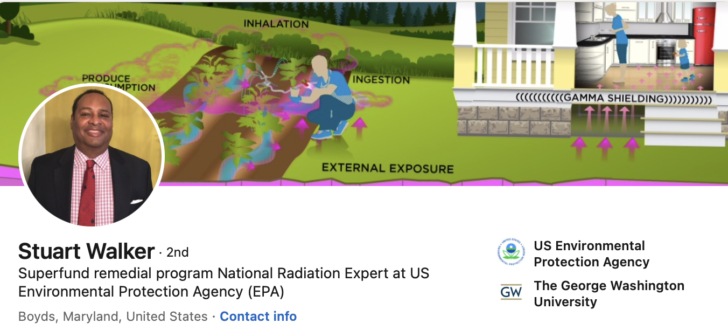
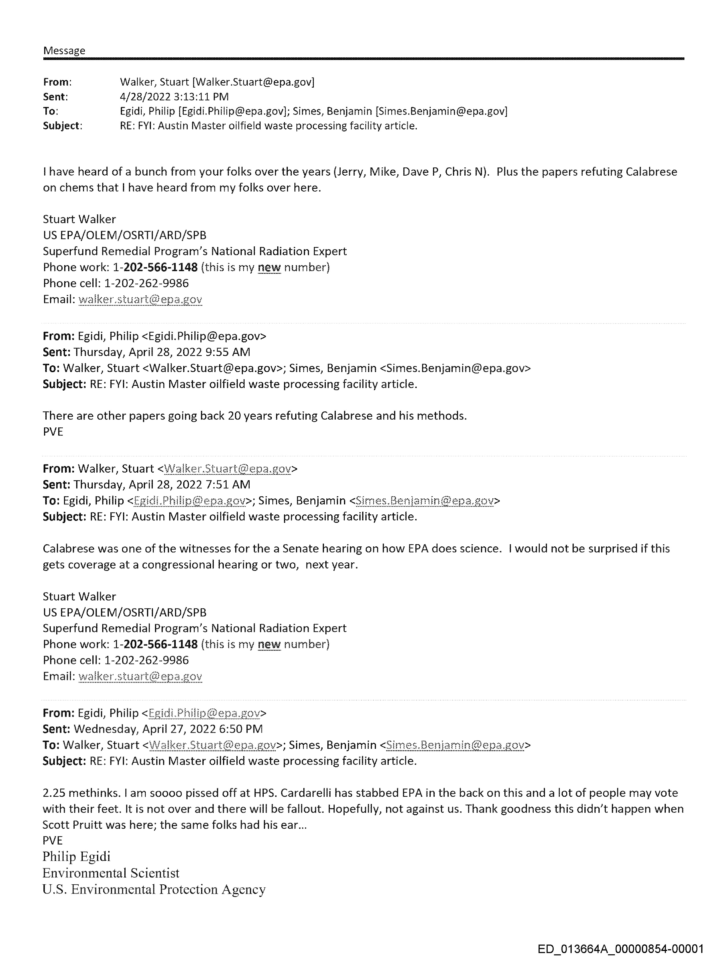
Final Thought For Now…
If you had the benefit of watching the HPS video series, it’s easy to make sense of the behavior revealed by the FOIA-ed emails. They are just a continuation of the same sort of intellectual and moral corruption that have unjustly burdened and misled society about the LNT and radiation safety.
Honest and transparent pursuit for the truth is a necessary part of science. The issues presented here are larger than a question about the validity of the LNT model for risk assessment. Without honesty and transparency, science cannot advance. And that is just what has happened to radiation safety science over the past almost 100 years.
Stay tuned.
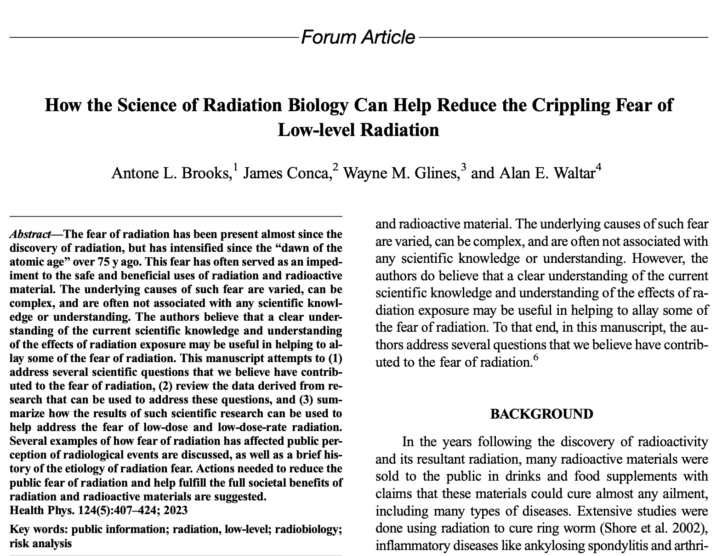
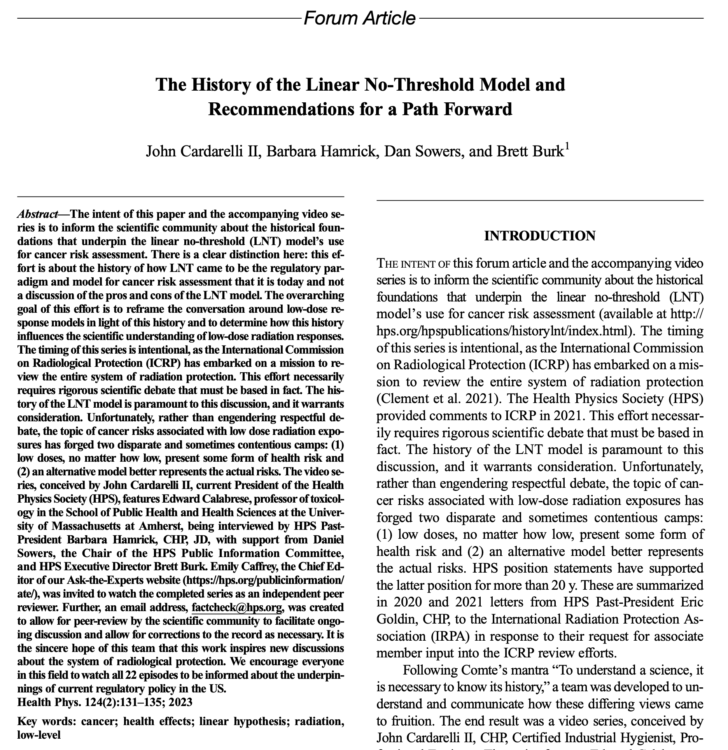

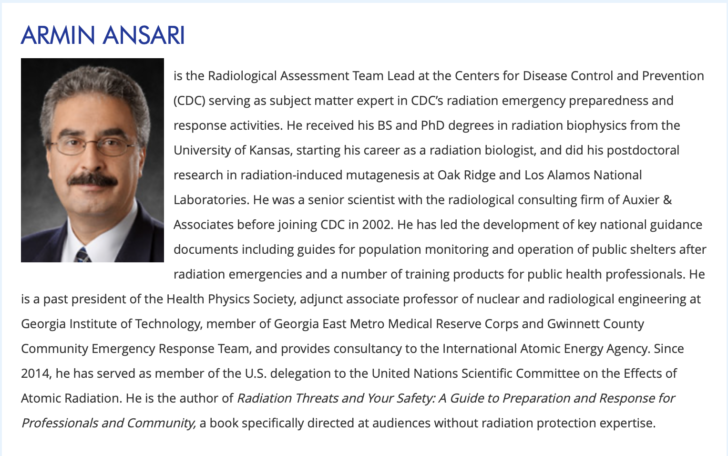


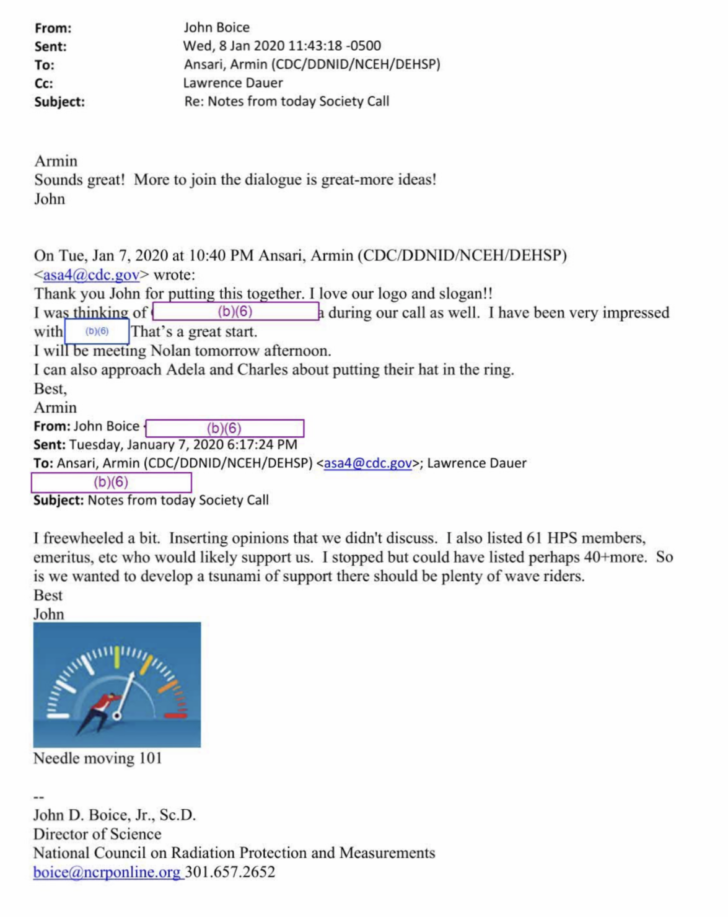
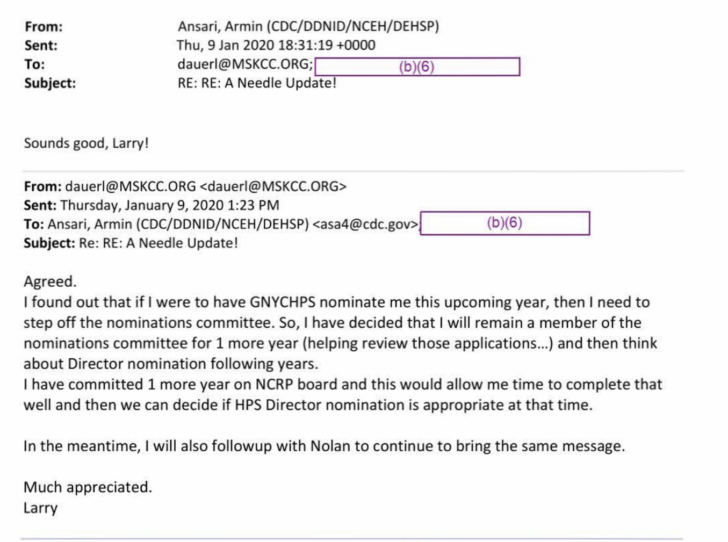

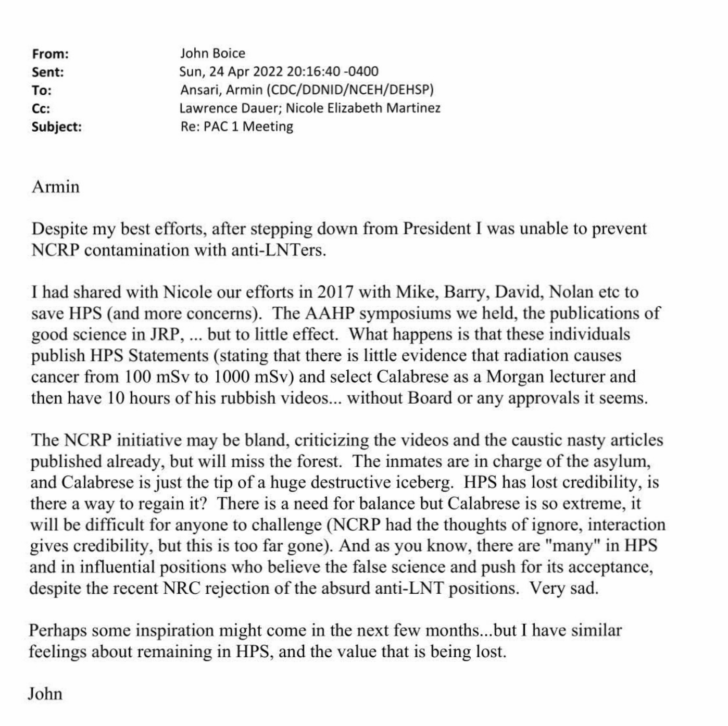
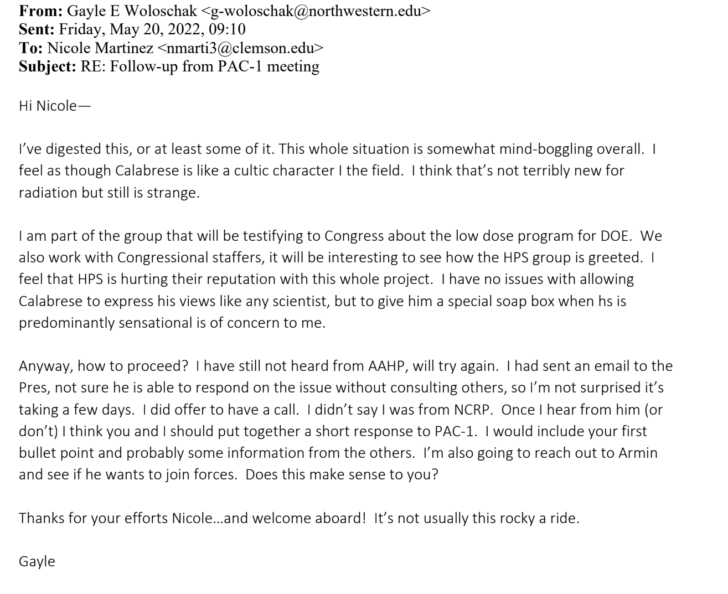
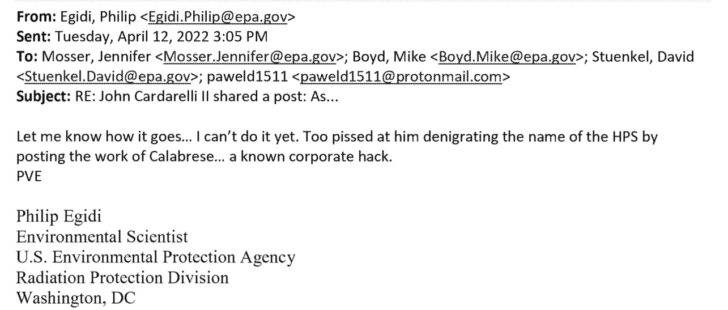
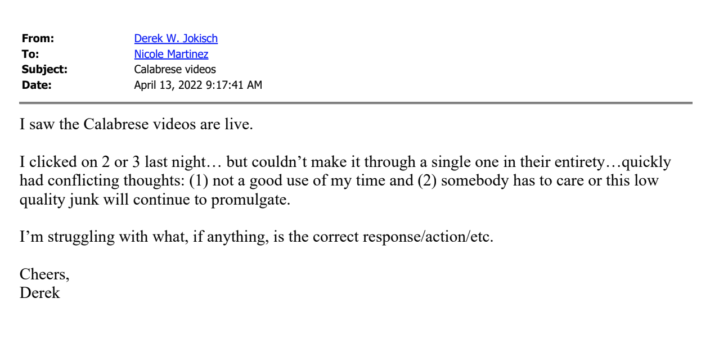
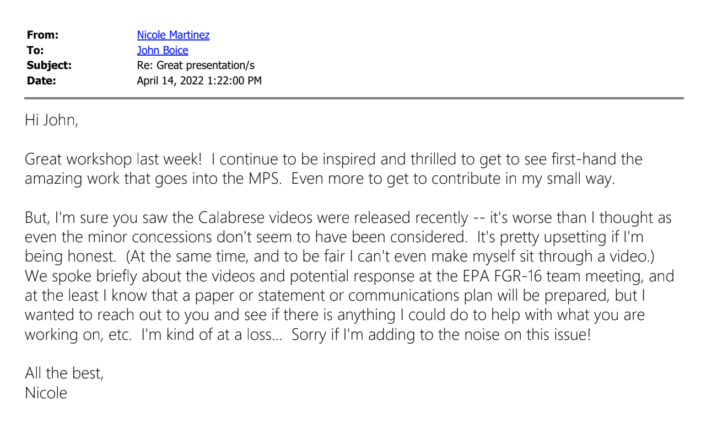
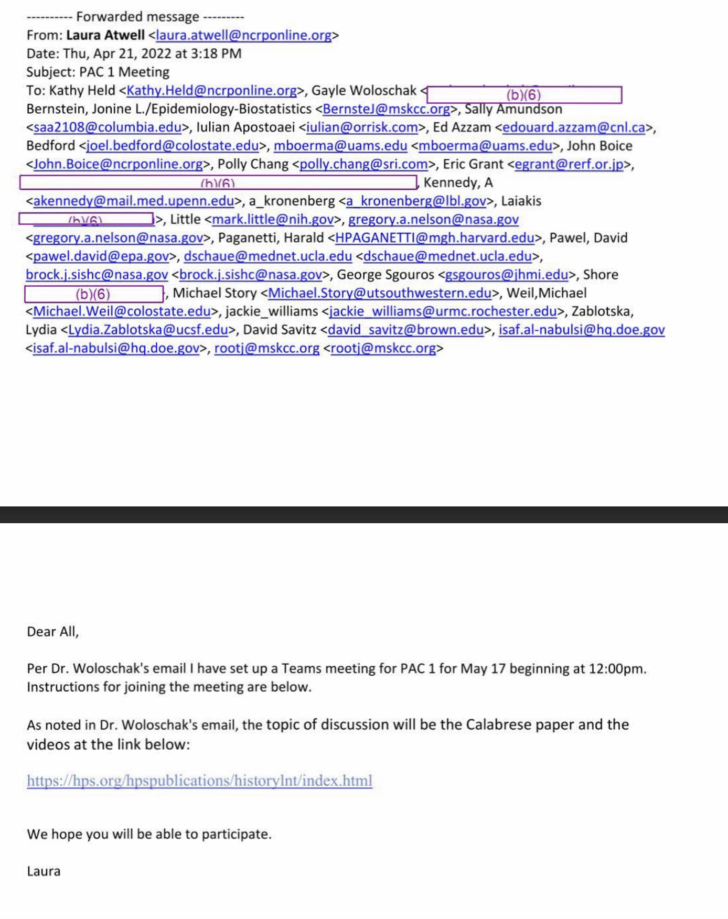

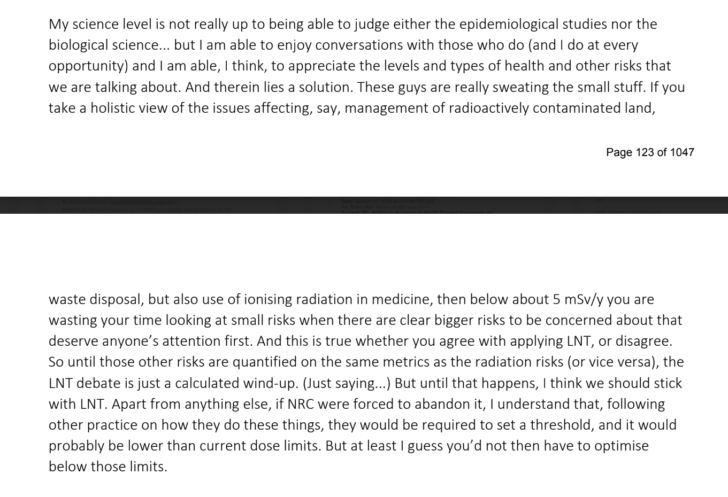
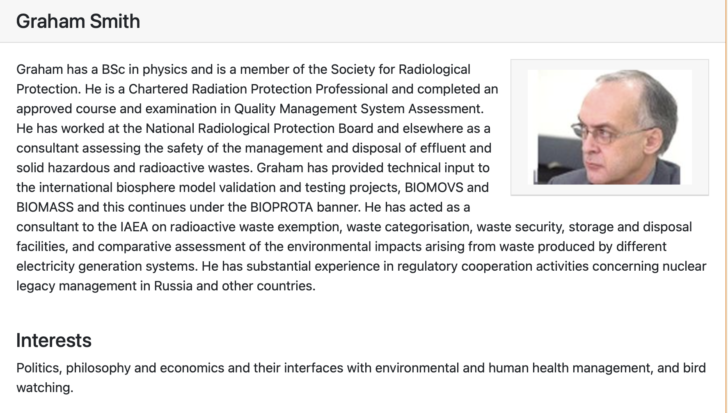
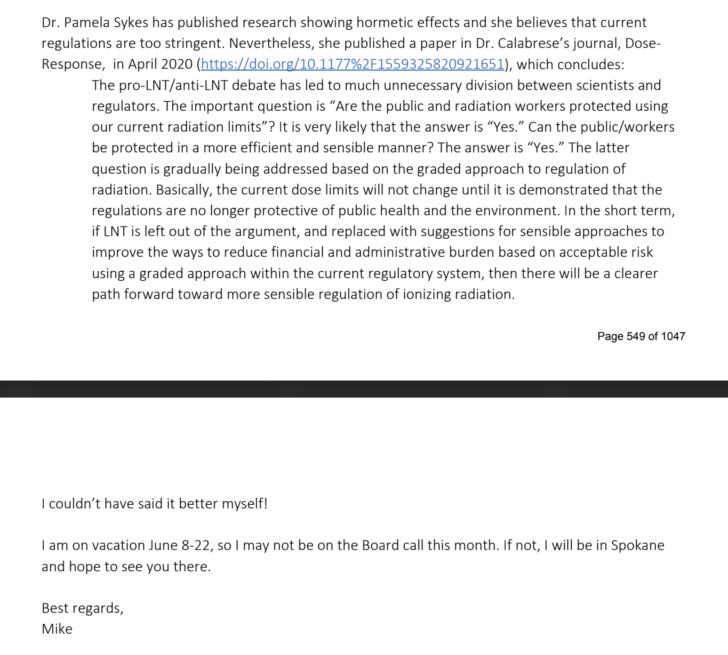
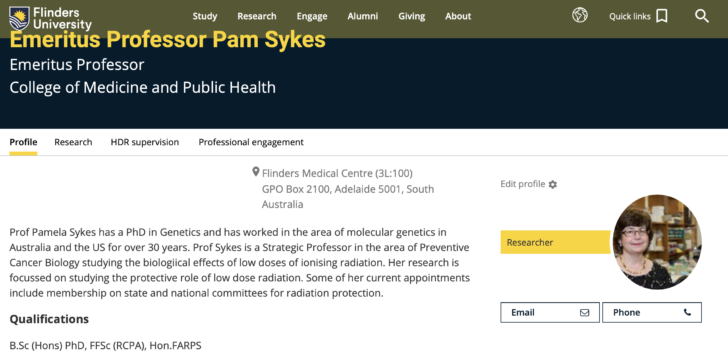
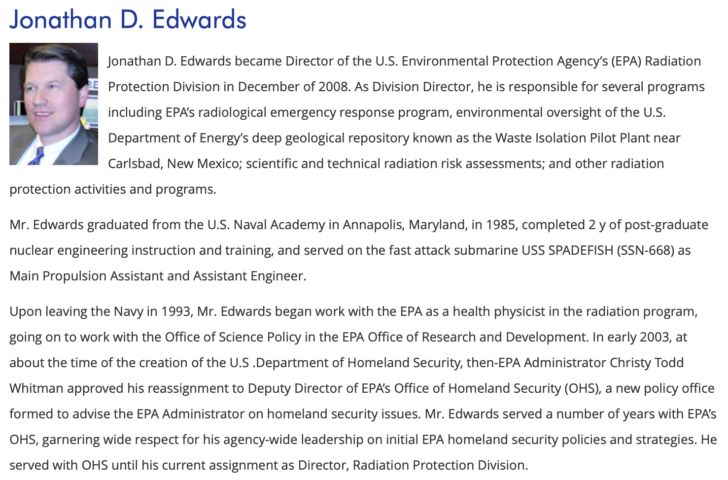
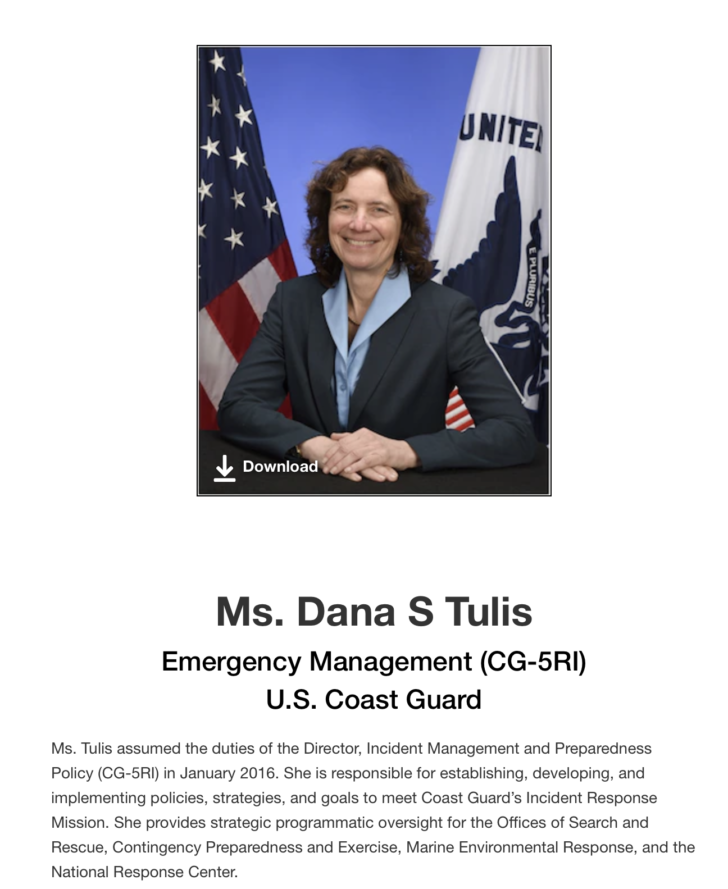
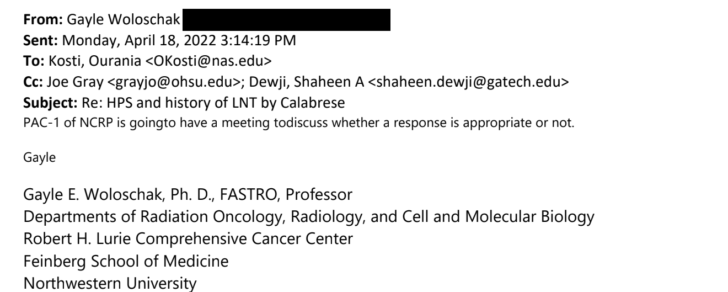
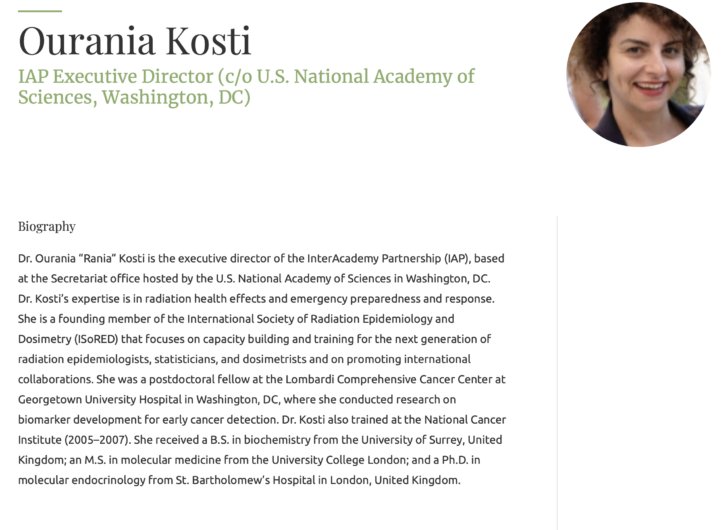

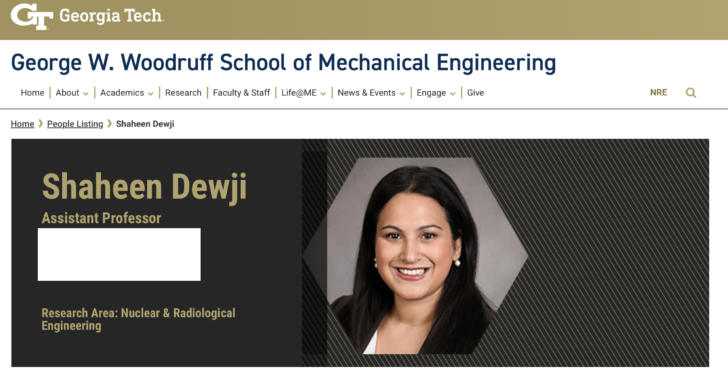


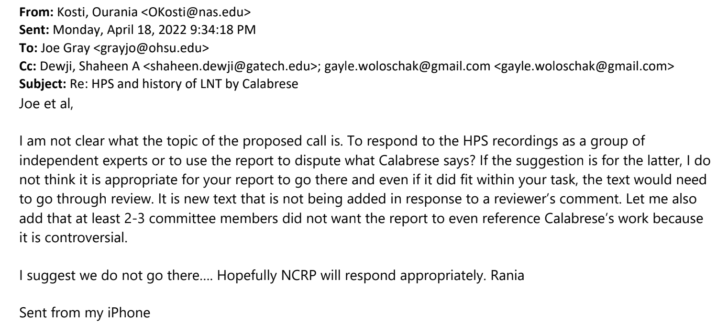
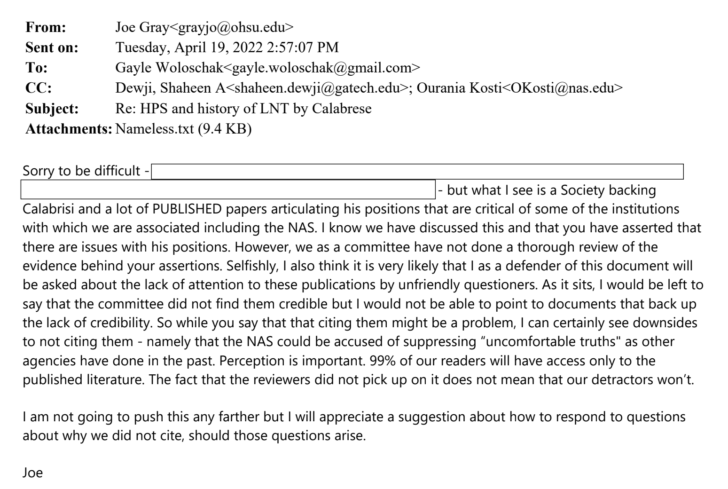
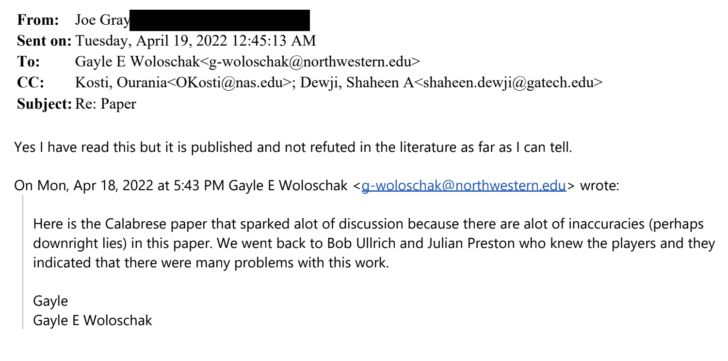

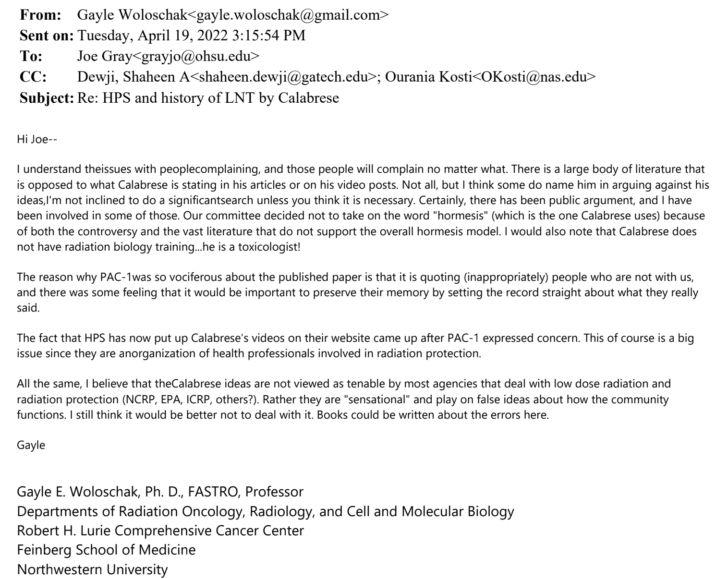
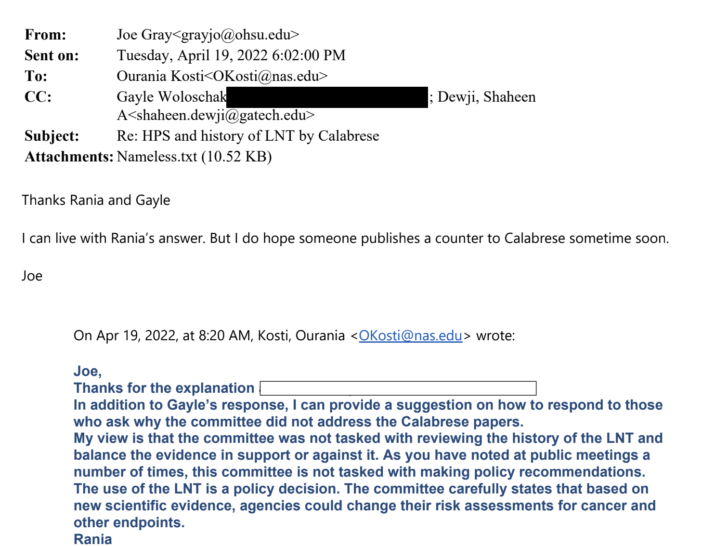
“I’d love to hear their reasons for clinging to a postulate that has been disproven.”
Exactly! Is it as simple as the fear of being revealed to be frauds? Or is it a case of “follow the money”? Or, indeed, both?
Nature abhors a straight line
I had the privilege to work with a fungus/yeast which could repair more DNA double strand breaks per cell than any other organism. It’s survival curve followed a 4th order curve. It took 400,000 rads to complete a survival curve, enough to turn a pyrex beaker a smoky straw colour. Thinking about radiation, then DNA irradiated in water would probably show a linear accumulation of damage. In the cell there are mitigation and repair mechanisms. Persistent un-repaired damage arises when these systems fail which will happen if the system is overwhelmed so there will never be a linear response until the defense capacity is is totally exceeded, then any extra radiation missile will be unchallenged. First, damage to DNA is often caused by free radicals, molecules ionised and energised by interaction with radiation packets (quanta). There are some molecules that can scavenge these radicals by reacting with them and absorbing the energy. As these are used up their effect declines. Then we have single strand damage. This can be repaired using the opposite strand as a template. Many people expose themselves to extreme radiation damage to get these – sunburn – which produces thymine dimers whose failed repair causes most melanomas. Then there are double strand (chromosome or chromatid) damage, effectively breaks. These can be repaired by recombination/conversion using the information from a sister chromatid or the second homologous chromosome from the other parent. All this can be error free while the repair system can keep up with the damage. There are also error prone pathways which fill single strand damage gaps randomly or can join any two unfixed chromosome ends together preventing further degeneration and gene loss. This is OK if the cell never divides again, but can be fatal if it does try. Anyone who has local radiation therapy then chemotherapy may find that irradiated areas reactivate to some degree. Radiation is most effective at causing chromosome damage and death, not very effective for producing point mutations. As for causing cancer, that is also a multi-mutation phenomenon, so will also not show a linear dose-response curve. With a high order power curve, ie dose squared, cubed, or higher, the pseudo linear bit is at high doses above where it falls over the cliff on whatever scale you plot the graph. On a simple dose response plot it will be linear above levels where the repair systems are overwhelmed. For risk comparison, we have between 100 and 500 cytocine deaminations per cell per day happening spontaneously and are repaired. These convert cytocine to a uridine derivative. https://www.nature.com/articles/s41598-017-07314-5 Bright sunshine can produce 50-100 TT dimers per second, too fast to fix. One milisievert produces about 2.5 base mutations, one DNA single strand break, or 0.04 double strand breaks. That means that a few seconds of sunlight do more radiation damage to your skin than any X-ray CT scan, and a few hours in the sun do more radiation damage to your skin than a theraputic dose of Xrays intended to kill cancer cells, although the type of damage will be different. The sun damage causes persistant mutations, the X-rays produce more lethal chromosome breaks which will kill the cells if they divide.
Energy engineering has a different approach. The heat energy coming to the earth comes from the sun; and nothing we have done effects that. That heat energy is either absorbed by the atmosphere or by the surface of the earth; and nothing we have done effects the total. The only thing that effects what we receive is how much sun energy is reflected back into space; and nothing has been done about that either.
Almost “Unbelievable”!! Thanks Steve, I’ll pass this on. The corruption of the “official scientific ” community is staggering.
Public Health Perspectives published a groundbreaking study in 2012 by MIT researchers Bevin P. Engelward and Jacquelyn C. Yanch refuting the NLT model in an experiment on long-term radiation effects on mice at up to 400 times background radiation levels. Those levels were also 10 times higher than the highest measured radiation levels in the evacuated communities surrounding the Fukushima Dai Ichi just a couple years after the core meltdown. Engelward and Yanch found no significant DNA damage in those mice; the theorized harbinger of future cancer as the LNT model incorrectly predicts.
See “Integrated Molecular Analysis Indicates Undetectable Change in DNA Damage in Mice after Continuous Irradiation at ~ 400-fold Natural Background Radiation” in Environmental Health Perspectives Vol. 120, No. 8 published 1 August 2012.
Not one of the people attacking Dr. Calabrese and his research asserts an argument that defends the LNT model with, well, science. I’d love to hear their reasons for clinging to a postulate that has been disproven. I’ll bet none have anything to do with science.